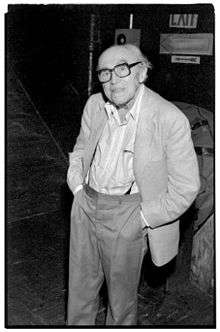Max Gordon (Village Vanguard founder)
| Max Gordon | |
|---|---|
 Gordon in 1983 | |
| Born |
March 12, 1903 Svir, Lithuania |
| Died |
May 11, 1989 (aged 86) New York City, New York, U.S. |
| Nationality | American |
| Occupation | Jazz club owner |
| Known for |
Jazz promotion Village Vanguard |
| Website |
villagevanguard |
Max Gordon (1903 – May 11, 1989)[1][2] was a jazz promoter and founder of the Village Vanguard jazz club in New York City.
Life and career
Born in Svir, Lithuania (now in Belarus), Gordon emigrated to the United States in 1908 at age five. The family settled in Portland, Oregon, where he later attended Reed College.[2][3] As a young man, he was interested in russian and french novels and saw himself as a romantic type.[3] Defying his parents' wishes that he become a lawyer, he moved to New York in 1926.[3][4]
In 1932 Gordon opened his first venue, Village Fair, in the tradition of Viennese coffee houses as a place for artists and writers. He relocated the venue once in 1934 and opened the Village Vanguard in 1935. The Vanguard initially offered poetry and was frequented by poets Maxwell Bodenheim and Harry Kemp. Over time, the club segued into cabaret acts, comedy, folk music and jazz before going exclusively jazz in 1957.[3] The club hosted a who's who of jazz greats from the 1940s to the 1980s including John Coltrane, Sidney Bechet, Dinah Washington, Albert Ayler, Miles Davis, Wynton Marsalis, Henry Threadgill and Thelonious Monk (at the time an unknown, discovered by Gordon's wife Lorraine).[2][5] The club's artistic direction was in part guided by Lorraine who had a keen interest in jazz.[3] Over time the club became a popular recording spot and over 100 jazz albums have been recorded there.[6]
Gordon sought new talent and gave younger performers a platform to showcase their work. In doing so he played a role in helping launch the careers of Judy Holliday, Betty Comden, Adolph Green, Barbra Streisand, Pearl Bailey, Woody Allen, Dick Gregory, Lenny Bruce, Irwin Corey, Woody Guthrie, and Lead Belly. He had a reputation for fairness and honesty among the performers.[2]
In addition to the Vanguard, in 1940s Gordon opened the Blue Angel club in midtown Manhattan and was involved in its operation for fourteen years.[2][3] He actively managed the Vanguard club well into his 80s.[1] In 1982 he authored a memoir titled Live at the Village Vanguard which chronicles the history of the club.[1][7]
Gordon died on May 11, 1989, at age 86.[2] Subsequently Lorraine Gordon continued the work and took an active role in managing the Vanguard club.[8]
Bibliography
- Max Gordon (1982). Live at the Village Vanguard. Da Capo Press. ISBN 9780306801600.
References
- 1 2 3 Burt A. Folkart (May 12, 1989). "Max Gordon; Village Vanguard Founder". Los Angeles Times. Archived from the original on December 8, 2015. Retrieved June 21, 2018.
- 1 2 3 4 5 6 Peter Watrous (May 12, 1989). "Max Gordon, 86, Jazz Promoter and Founder of Vanguard, Dies". New York Times. Archived from the original on December 20, 2017. Retrieved June 21, 2018.
- 1 2 3 4 5 6 Gilbert Millstein (June 12, 1977). "Max Gordon the Man Behind the Vanguard". New York Times. Archived from the original on June 22, 2018. Retrieved June 21, 2018.
- ↑ Whitney Balliett (2002). Collected Works: A Journal of Jazz 1954–2001. Macmillan. p. 720. ISBN 9780312270087. Retrieved June 23, 2018.
- ↑ Lara Pellegrinelli (June 9, 2018). "Lorraine Gordon, Guardian of Legendary Jazz Club, Dies at 95". National Public Radio. Archived from the original on June 18, 2018. Retrieved June 21, 2018.
- ↑ "Why Everyone Wants to Record 'Live at the Village Vanguard'". National Public Radio. October 22, 2015. Archived from the original on June 18, 2018. Retrieved June 23, 2018.
- ↑ Max Gordon (1982). Live at the Village Vanguard. Da Capo Press. ISBN 9780306801600. Retrieved June 21, 2018.
- ↑ Ashley Kahn (February 8, 2005). "After 70 Years, the Village Vanguard Is Still in the Jazz Swing". The Wall Street Journal. Archived from the original on August 5, 2016. Retrieved June 23, 2018.